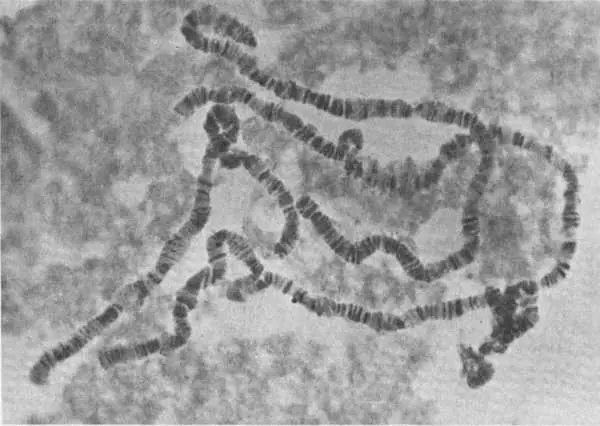Айзек Азимов - The Genetic Effects of Radiation
Здесь есть возможность читать онлайн «Айзек Азимов - The Genetic Effects of Radiation» весь текст электронной книги совершенно бесплатно (целиком полную версию без сокращений). В некоторых случаях можно слушать аудио, скачать через торрент в формате fb2 и присутствует краткое содержание. Год выпуска: 2018, Издательство: epubBooks Classics, Жанр: Медицина, Биология, на английском языке. Описание произведения, (предисловие) а так же отзывы посетителей доступны на портале библиотеки ЛибКат.
- Название:The Genetic Effects of Radiation
- Автор:
- Издательство:epubBooks Classics
- Жанр:
- Год:2018
- ISBN:нет данных
- Рейтинг книги:4 / 5. Голосов: 1
-
Избранное:Добавить в избранное
- Отзывы:
-
Ваша оценка:
- 80
- 1
- 2
- 3
- 4
- 5
The Genetic Effects of Radiation: краткое содержание, описание и аннотация
Предлагаем к чтению аннотацию, описание, краткое содержание или предисловие (зависит от того, что написал сам автор книги «The Genetic Effects of Radiation»). Если вы не нашли необходимую информацию о книге — напишите в комментариях, мы постараемся отыскать её.
The Genetic Effects of Radiation — читать онлайн бесплатно полную книгу (весь текст) целиком
Ниже представлен текст книги, разбитый по страницам. Система сохранения места последней прочитанной страницы, позволяет с удобством читать онлайн бесплатно книгу «The Genetic Effects of Radiation», без необходимости каждый раз заново искать на чём Вы остановились. Поставьте закладку, и сможете в любой момент перейти на страницу, на которой закончили чтение.
Интервал:
Закладка:
The separate chromosomes in a dividing cell are photographed and then can be identified by their overall length, the position of the centromere, or point where the two strands join, and other characteristics. The photomicrograph can then be cut apart and the chromosomes grouped in a karyotype, which is an arrangement according to a standard classification to show chromosome complement and abnormalities. The karotype below is of a normal male, since it shows X and Y sex chromosomes and 22 pairs of other, autosomal, chromosomes. By contrast, the cells in the upper pictures are abnormal, with only 45 chromosomes each.
In this way, the fundamental “instructions” that determine the characteristics of a cell are passed on to each new cell. Ideally, all the trillions of cells in a particular human being have identical sets of “instructions”. [1] For more detail about cell division, see Radioisotopes and Life Processes , another booklet in this series.
Enzymes and Genes
Each cell is a tiny chemical factory in which several thousand different kinds of chemical changes are constantly taking place among the numerous sorts of molecules that move about in its fluid or that are pinned to its solid structures. These chemical changes are guided and controlled by the existence of as many thousands of different enzymes within the cell.
Enzymes possess large molecules built up of some 20 different, but chemically related, units called amino acids . A particular enzyme molecule may contain a single amino acid of one type, five of another, several dozen of still another and so on. All the units are strung together in some specific pattern in one long chain, or in a small number of closely connected chains.
Every different pattern of amino acids forms a molecule with its own set of properties, and there are an enormous number of patterns possible. In an enzyme molecule made up of 500 amino acids, the number of possible patterns can be expressed by a 1 followed by 1100 zeroes (10¹¹⁰⁰).
Every cell has the capacity of choosing among this unimaginable number of possible patterns and selecting those characteristic of itself. It therefore ends with a complement of specific enzymes that guide its own chemical changes and, consequently, its properties and its behavior. The “instructions” that enable a fertilized ovum to develop in the proper manner are essentially “instructions” for choosing a particular set of enzyme patterns out of all those possible.
The differences in the enzyme–guided behavior of the cells making up different species show themselves in differences in body structure. We cannot completely follow the long and intricate chain of cause–and–effect that leads from one set of enzymes to the long neck of a giraffe and from another set of enzymes to the large brain of a man, but we are sure that the chain is there. Even within a species, different individuals will have slight distinctions among their sets of enzymes and this accounts for the fact that no two human beings are exactly alike (leaving identical twins out of consideration).
Each chromosome can be considered as being composed of small sections called genes , usually pictured as being strung along the length of the chromosome. Each gene is considered to be responsible for the formation of a chain of amino acids in a fixed pattern. The formation is guided by the details of the gene’s own structure (which are the “instructions” earlier referred to). This gene structure, which can be translated into an enzyme’s structure, is now called the genetic code .

Stained section of one cell from salivary gland of Drosophila, or fruit flies, reveals dark bands that may be genes controlling specific traits.
If a particular enzyme (or group of enzymes) is, for any reason, formed imperfectly or not at all, this may show up as some visible abnormality of the body—an inability to see color, for instance, or the possession of two joints in each finger rather than three. It is much easier to observe physical differences than some delicate change in the enzyme pattern of the cells. Genes are therefore usually referred to by the body change they bring about, and one can, for instance, speak of a “gene for color blindness”.
A gene may exist in two or more varieties, each producing a slightly different enzyme, a situation that is reflected, in turn, in slight changes in body characteristics. Thus, there are genes governing eye color, one of which is sufficiently important to be considered a “gene for blue eyes” and another a “gene for brown eyes”. One or the other, but not both, will be found in a specific place on a specific chromosome.
The two chromosomes of a particular pair govern identical sets of characteristics. Both, for instance, will have a place for genes governing eye color. If we consider only the most important of the varieties involved, those on each chromosome of the pair may be identical; both may be for blue eyes or both may be for brown eyes. In that case, the individual is homozygous for that characteristic and may be referred to as a homozygote . The chromosomes of the pair may carry different varieties: A gene for blue eyes on one chromosome and one for brown eyes on the other. The individual is then heterozygous for that characteristic and may be referred to as a heterozygote . Naturally, particular individuals may be homozygous for some types of characteristics and heterozygous for others.
When an individual is heterozygous for a particular characteristic, it frequently happens that he shows the effect associated with only one of the gene varieties. If he possesses both a gene for brown eyes and one for blue eyes, his eyes are just as brown as though he had carried two genes for brown eyes. The gene for brown eyes is dominant in this case while the gene for blue eyes is recessive .
Parents and Offspring
How does the fertilized ovum obtain its particular set of chromosomes in the first place?
Each adult possesses gonads in which sex cells are formed. In the male, sperm cells are formed in the testes; in the female, egg cells are formed in the ovaries.
In the formation of the sperm cells and egg cells there is a key step— meiosis —a cell division in which the chromosomes group into pairs and are then apportioned between the daughter cells, one of each pair to each cell. Such a division, unaccompanied by replication, means that in place of the usual 23 pairs of chromosomes in each other cell, each sex cell has 23 individual chromosomes, a “half–set”, so to speak.
In the process of fertilization, a sperm cell from the father enters and merges with an egg cell from the mother. The fertilized ovum that results now has a full set of 23 pairs of chromosomes, but of each pair, one comes from the father and one from the mother.
In this way, each newborn child is a true individual, with its characteristics based on a random reshuffling of chromosomes. In forming the sex cells, the chromosome pairs can separate in either fashion ( a into cell 1 and b into cell 2, or vice versa). If each of 23 pairs does this randomly, nearly 10 million different combinations of chromosomes are possible in the sex cells of a single individual.
Furthermore, one can’t predict which chromosome combination in the sperm cell will end up in combination with which in the egg cell, so that by this reasoning, a single married couple could produce children with any of 100 trillion (100,000,000,000,000) possible chromosome combinations.
Читать дальшеИнтервал:
Закладка:
Похожие книги на «The Genetic Effects of Radiation»
Представляем Вашему вниманию похожие книги на «The Genetic Effects of Radiation» списком для выбора. Мы отобрали схожую по названию и смыслу литературу в надежде предоставить читателям больше вариантов отыскать новые, интересные, ещё непрочитанные произведения.
Обсуждение, отзывы о книге «The Genetic Effects of Radiation» и просто собственные мнения читателей. Оставьте ваши комментарии, напишите, что Вы думаете о произведении, его смысле или главных героях. Укажите что конкретно понравилось, а что нет, и почему Вы так считаете.








![Айзек Азимов - Земля Ханаанская. Родина иудаизма и христианства[The Land of Canaan]](/books/172206/ajzek-azimov-zemlya-hanaanskaya-rodina-iudaizma-i-h-thumb.webp)



